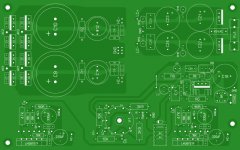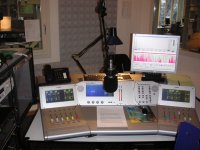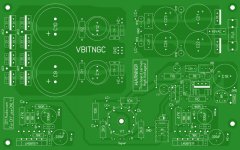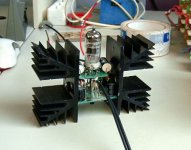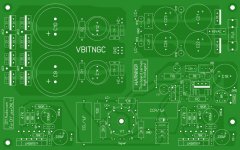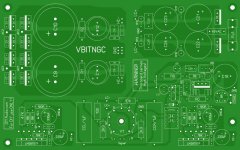I recommend to move the left channel 3k9 resistor directly to pin 7 of the tube socket.
The purpose of this resistor is to avoid oscillations, so called gridstopper.
On your actual layout, the trace leading to pin 7 could pick up some RF noise.
Kind regards
Franz
The purpose of this resistor is to avoid oscillations, so called gridstopper.
On your actual layout, the trace leading to pin 7 could pick up some RF noise.
Kind regards
Franz
Hey Franz, nice to see you back in this thread... now that I have mastered this basic valve circuit I have some questions...
I looked at a number of other ECC88 circuits and found the one in our buffer rather unusual, if more simplistic...
No doubt it works , as mine runs dead quiet, except maybe with no source material being played, with the pot as it turns between 2 and 5 o' clock positions a slight amount of noise is heard.
What I want to know is, why don't I see other people using dual supplies, what do you call this type of arrangement that you used the valve in?
I have looked at
Common cathode stage, bypassed and unbypassed cathode.
The single stage inverting feedback amp.
I would like to learn some of the basic math.
like how to calculate gain, impendance, capacitance and frequency response.
P.S. is you postal address still the same?
I looked at a number of other ECC88 circuits and found the one in our buffer rather unusual, if more simplistic...
No doubt it works , as mine runs dead quiet, except maybe with no source material being played, with the pot as it turns between 2 and 5 o' clock positions a slight amount of noise is heard.
What I want to know is, why don't I see other people using dual supplies, what do you call this type of arrangement that you used the valve in?
I have looked at
Common cathode stage, bypassed and unbypassed cathode.
The single stage inverting feedback amp.
I would like to learn some of the basic math.
like how to calculate gain, impendance, capacitance and frequency response.
P.S. is you postal address still the same?
Hi Nico
No secret in this circuit: it is a cathode follower, unity gain or a little bit less.
The symmetrical power supply is suiting better to the middle ground, as the power chip is supplied by symmetrical power too.
This circuit is well documented at Joe Rasmussens site. As very good books I recommend Morgan Jones, Valve Amplifiers.
Yes, my addresse is still the same.
Kind regards
Franz
No secret in this circuit: it is a cathode follower, unity gain or a little bit less.
The symmetrical power supply is suiting better to the middle ground, as the power chip is supplied by symmetrical power too.
This circuit is well documented at Joe Rasmussens site. As very good books I recommend Morgan Jones, Valve Amplifiers.
Yes, my addresse is still the same.
Kind regards
Franz
Ohh, I was never really absent, here!
I follow with interest your design, Wim.
In the last three weeks, I was occupied by some different "toys": we implemented three new Broadcast Studio Mixer Consoles: OnAir2000 from Studer, in our broadcast studios 😀
Franz
I follow with interest your design, Wim.
In the last three weeks, I was occupied by some different "toys": we implemented three new Broadcast Studio Mixer Consoles: OnAir2000 from Studer, in our broadcast studios 😀
Franz
Attachments
Franz G said:.....In the last three weeks, I was occupied by some different "toys": we implemented three new Broadcast Studio Mixer Consoles: OnAir2000 from Studer, in our broadcast studios 😀 Franz ...
Looks like someone is enjoying their new job... 😉
Yes, now you will have the choice of any tube from the ECC88 family (when you have enough filament current, about 450mA max. for example to use E288CC) and no risk to have an oscillating buffer.
BTW: I got many 6922 tubes for free from my local dealer: all this tubes had oscillating problems in some Vincent amps. Vincent replaced this tubes under warranty 😎
Franz
P.S.
Why not add some pads and holes for the coupling caps? Now you will find enough space and good position. You can foresee more than two holes, to use different sizes of caps.
BTW: I got many 6922 tubes for free from my local dealer: all this tubes had oscillating problems in some Vincent amps. Vincent replaced this tubes under warranty 😎
Franz
P.S.
Why not add some pads and holes for the coupling caps? Now you will find enough space and good position. You can foresee more than two holes, to use different sizes of caps.
The maximum space available for the coupling cap's is 26,7x10,16 with a pitch of 29,6. The capacitors I have at hand are 1µF/630V Angela's Fastcap's, an axial model. Also one of the smaller types you can find with this value. If somebody has suggestions to include other pitches let me know and I will add them. As for the size, well thats pretty much it as you can see.
Regards
P.S. CCL and CCR stands for "Coupling Cap Left" and "Coupling Cap Right"😉
Regards
P.S. CCL and CCR stands for "Coupling Cap Left" and "Coupling Cap Right"😉
Attachments
Gewa
I like this board now, as it is a complete solution.
It seems ready for prototyping 😎
Franz
I like this board now, as it is a complete solution.
It seems ready for prototyping 😎
Franz
Same to me (2 boards).
It seems to be fair that we share the costs of the prototype and a free board fo GeWa for all the work he did.
It seems to be fair that we share the costs of the prototype and a free board fo GeWa for all the work he did.
Can you make both of those caps run from top to bottom like the left one... that way if you want to use larger polyprops they can be made to fit
OK Nordic, here you have it.
I think this is the best we can get given the dimensions of the eurocard.
If Zang is willing to have these boards made I will email him the Gerber and drill files.
First let us check and doublecheck if there are no errors in the layout.
Regards
I think this is the best we can get given the dimensions of the eurocard.
If Zang is willing to have these boards made I will email him the Gerber and drill files.
First let us check and doublecheck if there are no errors in the layout.
Regards
Attachments
- Status
- Not open for further replies.
- Home
- Amplifiers
- Chip Amps
- VBITNGC building & comment
